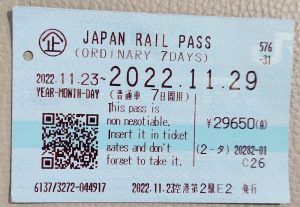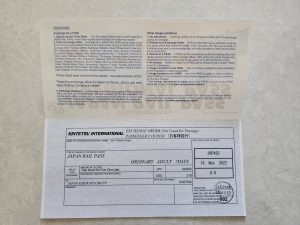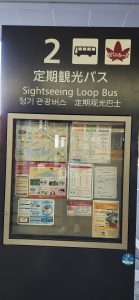Japan has finally opened up for tourists! It’s been a rough couple of years, and it is so refreshing to have travel options open up again. For those who want to travel around Japan, you may want to consider purchasing a Japan Rail (JR) pass.
What is the JR Pass?
The JR Pass offers unlimited travel around Japan on trains, including the high speed “shinkansen” trains, operated by the JR company. They offer passes for 7 (29,650 yen or ~$215.87 USD), 14 (47,250 yen or ~$344.01 USD), or 21 days (60,450 yen or ~$440.11 USD), and you will need to be a foreign national visiting Japan under the “Temporary visitor” status for these prices. With the JR pass, seat reservations are free of charge, and you can easily make these reservations at a JR ticket office or at JR ticket machines around the stations.
Is the JR Pass worth it?
This depends on what your travel plans are. If you plan to travel long distance around Japan, such as a round trip between Tokyo and Kyoto/Osaka, then you may want to consider getting the pass since the cost of the round trip ticket is almost the same as the cost of a 7-day JR pass. At the time of this writing, a round trip high speed train ticket between Tokyo and Osaka is 29,040 yen (~$211.43 USD) and the cost of the an ordinary JR pass is 29,650 yen (~$215.87 USD). Throw in a trip to Hiroshima (one way from Osaka to Hiroshima is 10,430 yen or $75.97 USD), and the pass is well worth it. This site has a helpful fare calculator for you to determine if a JR pass is right for your travel plans.
How to get the JR Pass?
To get a JR pass at the best price you will need to order the pass online before your trip to Japan. If you do a search on JR pass, you will see that there are a number of companies offering the JR Pass, and prices are very similar, so it’s more of a personal preference for which company you choose. If you decide to purchase the pass, make sure you allow for enough time for them to mail out the paper exchange order to your address overseas. I got mine within a week, but to be safe you should order well enough in advance (some sites say 2 weeks).
You can also get the JR Pass while in Japan, but it is more expensive when you are in Japan. To give you an idea a 7 day exchange order purchased overseas is 29,650 yen (~$215.87 USD) while a 7 day pass purchased in Japan is 33,610 yen (~$244.70 USD).
It is important to note that the exchange order you receive in the mail is not the actual pass that you use for the trains. Once you arrive in Japan, you will need to go to a JR ticket office to exchange for a JR pass to use at the train stations and activate the pass. To activate the pass, you will need to show your passport with the temporary visitor stamp, the exchange order you received and provide the date for when you want to start using the pass. Once you set the date you cannot change it.

This is the actual Japan Rail (JR) Pass you will receive when you turn in your exchange order. This pass can be used directly as a ticket at the JR train stations
For those flying into Tokyo, there is a JR ticket office that you can activate at the Narita airport and start using the pass for the Narita Express to get into Tokyo. However, if you don’t plan on traveling long distance that day you may not want to activate the pass just yet, since the cost of the Narita Express to get to Tokyo is only around 3000 yen.
The disadvantages of the JR Pass
Many articles talk about the benefits of JR Pass, but there are also disadvantages of the JR pass:
- JR train stations are not always available or convenient in local areas, and you may end up needing to purchase additional tickets or passes to get around.
- Can you travel only with the JR pass in local areas? Possibly, but be prepared to walk far or take inconvenient routes to get to/from your destinations. For example, in Tokyo, the closest JR station to Toyosu/Tsukiji is the Shimbashi station, and it is a~25-min walk to the Tsukiji area and a 50-min walk to the Toyosu area (where the fish auction and famous Sushi Dai restaurant are).
- You may also not be able to get to certain destinations like Hakone since the Odakyu line is not included on the JR pass.
- You don’t have access to all high speed bullet trains – the fastest and most frequent Nozomi trains and Muzuho trains are not included with the JR Pass. Instead, you will need to take the Hikari or Sakura trains on the same route.
- You have to use it on consecutive days. For those who may want to stay in local areas to explore for a few days, you will be “wasting” your pass days by not using the pass for long distance during those local days. While you can use the pass locally, it is likely not that convenient to use to get around (see first bullet above), so you will likely not be using the pass much during those local days.
- There may be cheaper options to get around such as flying, local trains, or buses. For example, a one way plane ticket from Tokyo NRT to Osaka KIX can be as low as $40 one way and takes less than 2 hours. You can also take slower local trains or overnight buses that can get you long distance at a fraction of the price, but it will take much longer.
When you should NOT get the JR Pass
- When you are traveling mostly locally. There are local/regional passes that are better and cheaper options for your travel plans.
- When you don’t plan on traveling long distance within the 7/14/21 day timeframes.
- If you want to take the Nozomi or Muzuho trains instead. These are not included with the JR Pass.
- When you want flexibility in your travel plans. If you don’t have set travel plans and want to hop on the next train heading out to your next destination, you may just want to buy train tickets as you go, which would also give you access to the faster, more frequent Nozomi trains.
- When you plan/prefer to fly instead.
Tips on using the JR Pass
- Activate your pass when you arrive in Japan, even if you are not using the pass that day. You can specify the day when you want to start using the pass, so you won’t have to worry about the stress of trying to find a ticket office to activate your pass the day you are traveling.
- Get seat reservations. Reservations come free with the JR pass, and it’s easy to reserve your seat. On the day of your travel, you can visit a JR ticket office to ask for a seat reservation, or you can reserve a seat using the ticket machines around JR stations. The pamphlet they provide you when you activate your pass will provide instructions on how to make those reservations yourself.
- The JR Pass looks like a regular paper train ticket. To use it, insert the ticket in the gated entrance when you enter and when you exit. Don’t lose it!
- If you are heading to Miyajima, the JR ferry to Miyajima is included in your pass.
- In Hiroshima, you can use your JR pass to get on the hop on/hop off sightseeing buses.
- In Osaka you can use the JR pass on the Osaka Loop Line, which can get you around most of Osaka.


